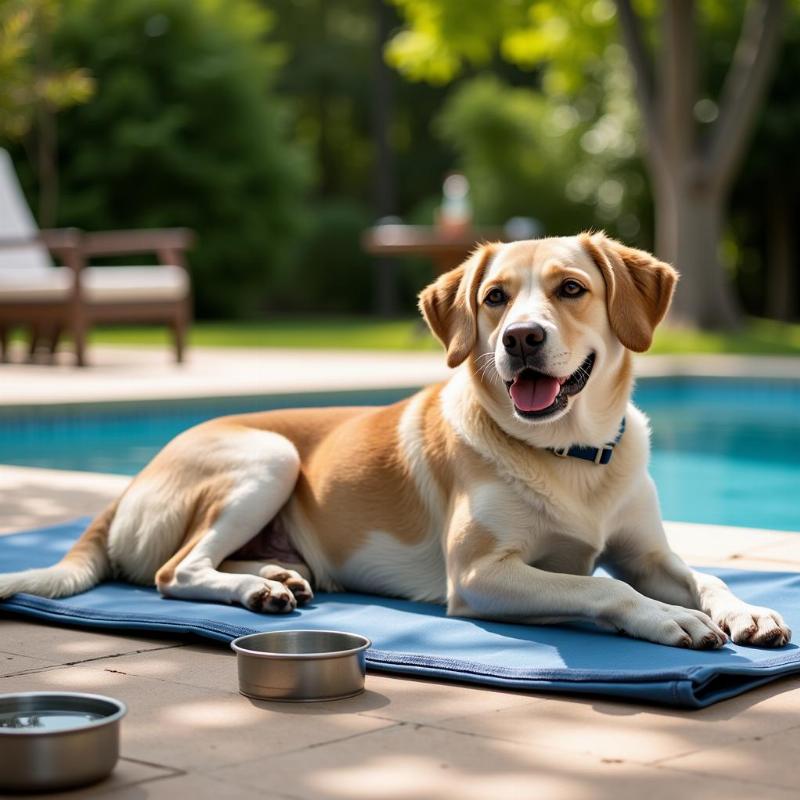Dogs, like humans, can experience a decrease in appetite during hot weather. This can be concerning for owners, especially if the dog exhibits other symptoms like lethargy or excessive panting. Understanding why your dog isn’t eating in the heat and knowing what to do can help ensure their health and well-being throughout the summer months.
While a slight dip in appetite during hot weather can be normal, prolonged refusal to eat requires attention. This article explores the reasons behind decreased appetite in dogs during hot weather, offers practical solutions, and guides you on when to seek veterinary care. We’ll cover everything from simple dietary adjustments to recognizing signs of heatstroke. So, let’s dive in and ensure your furry friend stays happy and healthy all summer long.
Why is My Dog Not Eating in Hot Weather?
There are several reasons why your canine companion might be turning up their nose at their food bowl when the mercury rises. Just as we might not feel like a heavy meal on a scorching day, dogs often prefer lighter fare or smaller portions in the heat. Their bodies are working overtime to regulate temperature, and digestion can add to their internal heat load.
Heat Stress and Discomfort
Heat stress plays a significant role in appetite suppression. When dogs overheat, their bodies prioritize cooling down over digestion. Panting, a primary cooling mechanism for dogs, also makes it difficult for them to eat comfortably.
Dehydration
Dehydration can also lead to loss of appetite. Make sure your dog has access to plenty of fresh, cool water, especially during hot weather. You can even add ice cubes to their water bowl for an extra refreshing treat.
Changes in Routine
Summer often brings changes in routine, including walks at different times or more time spent indoors. These shifts can disrupt your dog’s normal eating habits.
What Can I Do to Encourage My Dog to Eat?
If your dog’s decreased appetite is due to the heat, there are several things you can try to encourage them to eat:
-
Offer Smaller, More Frequent Meals: Instead of two large meals, try offering several smaller meals throughout the day, especially during the cooler parts of the morning and evening.
-
Adjust Meal Times: Shift mealtimes to the coolest parts of the day – early morning or late evening.
-
Provide Cool Food: Serve food at a cooler temperature. Consider adding a few ice cubes to their water or offering frozen treats like dog-friendly popsicles.
-
Make Food More Appealing: Enhance the palatability of their food by adding a small amount of low-sodium chicken broth or plain, unsweetened yogurt.
-
Ensure Hydration: Always provide access to fresh, cool water. Consider adding a water fountain to encourage drinking.
When to Seek Veterinary Care
While a slight decrease in appetite during hot weather is often normal, there are times when it’s essential to seek veterinary care:
- Complete Loss of Appetite: If your dog refuses to eat anything for more than 24 hours, contact your veterinarian.
- Other Symptoms: If your dog exhibits other symptoms like vomiting, diarrhea, lethargy, excessive panting, or difficulty breathing, seek immediate veterinary attention. These could be signs of heatstroke or another serious illness.
Keeping Your Dog Cool and Comfortable
Beyond encouraging eating, focus on keeping your dog cool and comfortable during hot weather:
-
Provide Shade and Ventilation: Ensure your dog has access to shady areas and well-ventilated spaces.
-
Limit Exercise During the Hottest Parts of the Day: Avoid strenuous exercise during peak heat hours. Opt for walks in the early morning or late evening.
-
Use Cooling Products: Consider using cooling mats, vests, or bandanas.
 Keeping Dog Cool in Summer
Keeping Dog Cool in Summer
Conclusion
A dog not eating in hot weather can be a common occurrence, often attributable to heat stress and discomfort. By making simple adjustments to meal times, food temperature, and portion sizes, you can encourage your furry friend to eat and stay healthy throughout the summer. Remember to prioritize hydration and provide a cool, comfortable environment for your dog. However, if your dog completely refuses food or displays other symptoms, it’s crucial to consult your veterinarian immediately. By staying informed and proactive, you can ensure your canine companion enjoys a happy and healthy summer.
FAQ
-
Is it normal for my dog to eat less in the summer? Yes, a slight decrease in appetite during hot weather is often normal.
-
How can I tell if my dog is dehydrated? Signs of dehydration include dry gums, sunken eyes, and loss of skin elasticity.
-
What should I feed my dog if they’re not eating their regular food in the heat? Try offering smaller, more frequent meals of their regular food, or try adding a small amount of low-sodium chicken broth or plain, unsweetened yogurt.
-
When should I be concerned about my dog’s decreased appetite? If your dog refuses to eat for more than 24 hours or exhibits other symptoms like vomiting, diarrhea, or lethargy, contact your veterinarian.
-
How can I help my dog stay cool in hot weather? Provide shade, ventilation, limit exercise during peak heat hours, and consider using cooling products.
-
Can I give my dog ice cubes? Yes, ice cubes are a safe and refreshing treat for dogs in hot weather.
-
What are the signs of heatstroke in dogs? Signs of heatstroke include excessive panting, rapid heartbeat, weakness, staggering, and collapse.
Beautdogs.us is your premier resource for all things dog-related in the US. We offer expert advice on dog breeds, care, and lifestyle. Whether you’re a seasoned dog owner or just starting your journey with a furry friend, Beautdogs.us provides reliable information, product recommendations, and valuable resources to help you navigate the world of dog ownership. Contact us today for any inquiries or to learn more about our services. Email: [email protected], Phone: +1 501-555-7529. Visit Beautdogs.us for more expert advice and guidance on all aspects of dog care.